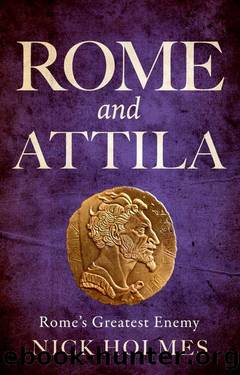Rome and Attila: Rome's Greatest Enemy by Nick Holmes

Author:Nick Holmes [Holmes, Nick]
Language: eng
Format: epub
Publisher: Puttenham Press
Published: 2024-02-07T00:00:00+00:00
24
Blitzkrieg in the West
In early 451, the Huns crossed the Rhine. The first major city to fall was Metz, ninety miles west of the Rhine. It was completely destroyed apart from a chapel dedicated to Stephen, the first Christian martyr. A legend quickly developed that God saved the chapel but punished the rest of the population since they were sinners.
This is typical of our few surviving sources on Attilaâs march into Gaul which are nearly all stories of Christian miracles, making it almost impossible to know what really happened. For example, Paris, or Lutetia as the Romans called it, was reputedly saved by a young peasant girl, Genevesa, who took a vow of chastity and led the city in what one historian has described as a prayer marathon. She subsequently became Parisâs patron saint, renamed Genevieve, and the modern-day Pantheon in the city, a huge neo-classical edifice, was originally dedicated to her before being converted in the French Revolution into a secular monument.
A tradition quickly sprang up, which dominates the surviving historical sources, that Attila was the âscourge of Godâ bringing punishment for the sins of the Gallo-Romans. The phrase was coined at the Gallic town of Troyes when its bishop went out to meet Attila and asked him who he was, whereupon the Hun apparently replied, âI am the scourge of god.â71 The humble bishop told Attila to take his life but to spare those of his congregation. According to the legend, this act of self-sacrifice prompted a miracle and â[the Huns] were blinded by heaven and they passed straight through, in one gate and out by another, neither seeing nor harming anyone.â
In Rheims, ninety miles west of Metz, another legend relates that the Huns were met by the bishop whom they promptly decapitated as he read from the Bible. But his head kept on talking as it rolled down the steps of the cathedral, causing them to flee in terror. Closer to the truth is probably that many Gallic towns survived not because they were populated by pious virgins and virtuous bishops, as the early Christians would have us believe, but because they had massive Roman fortifications built by the late Roman emperors, Aurelian and Diocletian, back in the third century. Some of these are still visible today. The modern French town of Sens is a good example where its enormous Roman walls that defied Attila have stood for over 1,500 years.
Meanwhile, as the Hunnic juggernaut smashed its way west, in the sunshine of southern Gaul at his court in Toulouse, Theodoric, king of the Visigoths, was still pondering what to do.
Aetius was of course desperate for his help. Our sources say he called on the help of a prominent Roman senator called Avitus, a friend of Theodoricâs, to meet the Visigothic king and argue for an alliance. Avitus is an interesting figure because he was highly regarded by both the Visigoths and the Romans. A Gallo-Roman aristocrat and a former soldier before becoming a senator, he held various senior positions in the western Roman government.
Download
This site does not store any files on its server. We only index and link to content provided by other sites. Please contact the content providers to delete copyright contents if any and email us, we'll remove relevant links or contents immediately.
| Central Asia | Southeast Asia |
| China | Hong Kong |
| India | Japan |
| Korea | Pakistan |
| Philippines | Russia |
The Rape of Nanking by Iris Chang(3530)
The Sympathizer by Viet Thanh Nguyen(3528)
World without end by Ken Follett(3016)
Ants Among Elephants by Sujatha Gidla(2930)
Blood and Sand by Alex Von Tunzelmann(2615)
Japanese Design by Patricia J. Graham(2564)
City of Djinns: a year in Delhi by William Dalrymple(2140)
Inglorious Empire by Shashi Tharoor(2106)
In Order to Live: A North Korean Girl's Journey to Freedom by Yeonmi Park(2063)
Foreign Devils on the Silk Road: The Search for the Lost Treasures of Central Asia by Peter Hopkirk(2061)
Tokyo by Rob Goss(2024)
India's Ancient Past by R.S. Sharma(1991)
India's biggest cover-up by Dhar Anuj(1990)
The Great Game: On Secret Service in High Asia by Peter Hopkirk(1963)
Tokyo Geek's Guide: Manga, Anime, Gaming, Cosplay, Toys, Idols & More - The Ultimate Guide to Japan's Otaku Culture by Simone Gianni(1953)
Goodbye Madame Butterfly(1941)
The Queen of Nothing by Holly Black(1768)
Living Silence in Burma by Christina Fink(1738)
Batik by Rudolf Smend(1726)
